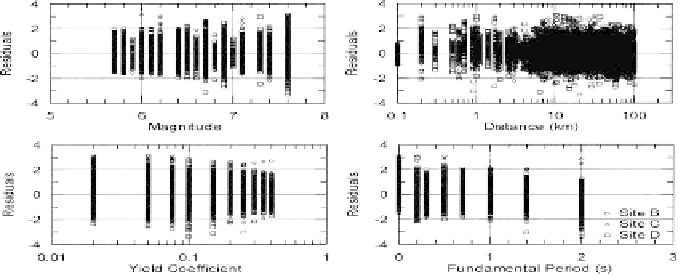Geoscience Reference
In-Depth Information
the ground motion hazard level and slope conditions specified. If not, the engineer must
calculate the amount of “nonzero” displacement
(
D
)
incentimeters using
333
ln
k
y
)
2
ln
(
D
)
=−
1
.
10
−
2
.
83ln
(
k
y
)
−
0
.
(
+
0
.
566ln
(
k
y
)
ln
(
S
a
(
1
.
5
T
s
))
2
+
3
.
04ln
(
S
a
(
1
.
5
T
s
))
−
0
.
244
(
ln
(
S
a
(
1
.
5
T
s
)))
+
1
.
5
T
s
+
0
.
278
(
M
−
7
)
±
ε
(14.5)
where:
k
y
,
T
s
,
and
S
a
(
1
.
5
T
s
)
areasdefinedpreviouslyforEq.(14.4),and
ε
isanormally-
distributed random variable with zero mean and standard deviation
σ
=
0
.
66. To elimi-
nate the bias in the model when
T
s
≈
0s, the first term of Eq. (14.5) should be replaced
with
−
0
.
22 when
T
s
<
0
.
05s. Because the standard deviation of Eq. (14.5) is 0.66 and
exp(0.66)
2, the median minus one standard deviation to median plus one standard
deviation range of seismic displacement can be approximately estimated as half the
medianestimatetotwicethemedianestimateofseismicdisplacement.Hence,themedian
seismicdisplacementcalculatedusingEq.(14.5)with
≈
0canbehalvedanddoubledto
developapproximatelythe16%to84%exceedanceseismicdisplacementrangeestimate.
ε
=
The residuals of Eq. (14.5) are plotted in Figure 14.12 vs. some key independent vari-
ables. The residuals of displacement vs. magnitude, distance, and yield coefficient show
no significant bias. There is only a moderate bias in the estimate at
T
s
0 and 2s. The
overestimation at 2s is not critical, because it is rare to have earth/waste sliding masses
with periods greater than 1.5s, and Eq. (14.5) is conservative. However, the rigid body
case (i.e.,
T
s
=
=
0) can be important for very shallow slides, and Eq. (14.5) is unconserv-
ative for this case. The estimation at
T
s
=
0s can be corrected by replacing the first term
−
.
−
.
(i.e.,
22. Hence, it is reasonable to use Eq. (14.5) for cases
where
T
s
rangesfrom0.05to2s,andthefirsttermoftheseequationsshouldbereplaced
with
1
10) in Eq. (14.5) with
0
−
0
.
22 if
T
s
<
0
.
05s.
It is often useful to establish a threshold displacement for acceptable seismic perfor-
mance and then estimate the probability of this threshold displacement being exceeded.
Fig. 14.12. Residuals
of Eq. (14.5) plotted vs. magnitude,
rupture distance, theyield coefficient, and the initial fundamental period
(Brayand Travasarou, 2007)
(
ln
D
data
-ln
D
predicted
)

